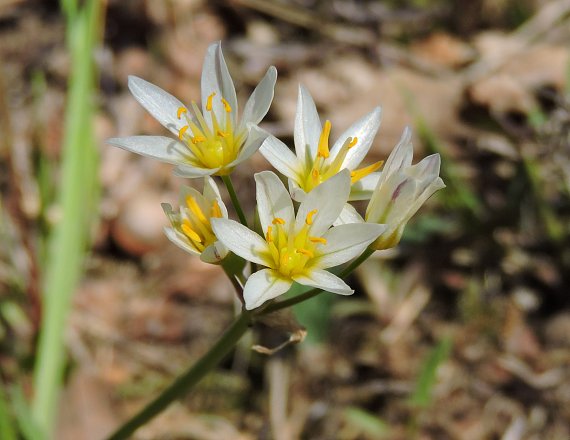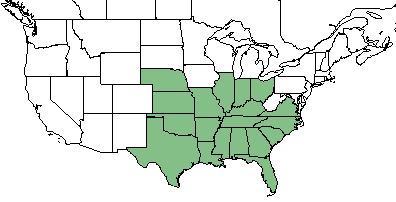Difference between revisions of "Nothoscordum bivalve"
(→Seed bank and germination) |
(→Seed bank and germination) |
||
| Line 42: | Line 42: | ||
===Seed bank and germination=== | ===Seed bank and germination=== | ||
| − | A period of stratification is required to end seed dormancy. Germination was most successful in | + | A period of stratification is required to end seed dormancy. Germination was most successful in a 14 week dark stratification, rather than light or 7 week stratification, and colder temperatures (15/6 °C 12/12 hr alternating intervals rather than 20/10 or 30/15 °C).<ref name="Baskin & Baskin 1979"/> |
<!--===Fire ecology===--> <!--Fire tolerance, fire dependence, adaptive fire responses--> | <!--===Fire ecology===--> <!--Fire tolerance, fire dependence, adaptive fire responses--> | ||
<!--===Pollination===--> | <!--===Pollination===--> | ||
Revision as of 15:03, 9 February 2018
| Nothoscordum bivalve | |
|---|---|

| |
| Photo from the Illinois Wildflowers Database | |
| Scientific classification | |
| Kingdom: | Plantae |
| Division: | Magnoliophyta - Flowering plants |
| Class: | Magnoliopsida - Dicots |
| Order: | Liliales |
| Family: | Liliaceae |
| Genus: | Nothoscordum |
| Species: | N. bivalve |
| Binomial name | |
| Nothoscordum bivalve L. | |

| |
| Natural range of Nothoscordum bivalve from USDA NRCS Plants Database. | |
Common names: grace garlic; false garlic;[1] crowpoison[2]
Contents
Taxonomic Notes
Synonym: Allium bivalve;[1][2] Ornithogalum bivalve[2]
Description
Nothoscordum bivalve is a bulbous[3] monoecious perennial forb/herb.[2] It is an onion-like plant but typically lacks an odor.[1]
Distribution
This species is found from southeastern Virginia, westward to southern Ohio and Kansas, southward to central peninsular Florida, Texas, and South America.[1]
Ecology
Habitat
N. bivalve occurs around granite flatrocks, in various glades and barrens, open woodlands, along roadsides, fields,[1][3] disturbed soils, low sandy woods, meadows, prairies, parking strips of towns, and rocky glades of limestone, chert, granite or sandstone. In Tennessee cedar (limestone) glades, N. bivalve is most abundant where soil is 10-15 cm deep. It can be found in glades that are flooded during winter and early spring and in those that are unflooded. During summer months in this habitat, soils moisture is frequently below the wilting coefficient.[3]
Associated species in Tennessee glades include Erigeron strigosus, Hypericum sphaerocarpum, Isanthus brachiatus, Isoetes butleri, Ophioglossum engelmanni, Petalostemon gattingeri, Psoralea subacaulis, Ruellia humilis, Satureja glabella, Scutellaria parvula, Senecio smallii, and Sporobolus vaginiflorus.[3]
Phenology
Seeds emerge from the soil in Tennessee glades during late February or early March and are fully elongated by late March and early April. Flowering here begins in early April, are in full flower by late April to early May, and ends by mid May. Green fruits and seeds occur from May first through the third week of May and ripe seeds occur from mid to late May. However, wet environments can shift the fruiting further into early to mid-June. Seeds are dispersed within 1-2 weeks of ripening. As seeds ripen, the stem turns yellow and dies about the time of seed dispersal. Bulblets are produced at the base of the plant between April and May. However, bulblets and/or seeds do not always occur, could both occur, or just one or the other. Roots also start dying at the same time as bulblets and completely die when the summer dry period sets in. In autumn, new roots grow that typically persist through winter. New leaves are also produced during autumn once soil moisture conditions become favorable. Autumn leaves die by mid-November, although it produces 1+ leaves that remain under the soil surface until late February or early March. Seed germination occurs from late March to mid-April. Warmer temperatures appear to trigger bulblet growth of roots and shoots. Root growth starts before the shoots and shoot growth seems more responsive to the temperature regime than roots. The optimal regime was a 30/15 °C 12/12 hr alternating interval.[3]
In the southeastern and mid-Atlantic United States, N. bivalve flowers from mid-March through mid-May and in September through December. Fruiting occurs in May through June and from October through January.[1] For the Florida panhandle, reports of flowering primarily occur from January through May, peaking between February and April. Records of flowering also occurred in September through November, but in reduced numbers compared to the spring.[4]
Seed bank and germination
A period of stratification is required to end seed dormancy. Germination was most successful in a 14 week dark stratification, rather than light or 7 week stratification, and colder temperatures (15/6 °C 12/12 hr alternating intervals rather than 20/10 or 30/15 °C).[3]
Use by animals
Herbivory by grazers is low for this species,[5] but trace amounts have been found in white tailed deer rumen of southern Texas.[6] Relative abundance peaks in properly grazed prairies and overgrazed but uneroded prairies.[5]
Conservation and Management
Cultivation and restoration
Photo Gallery
References and notes
- ↑ 1.0 1.1 1.2 1.3 1.4 1.5 Weakley AS (2015) Flora of the Southern and Mid-Atlantic States. Chapel Hill, NC: University of North Carolina Herbarium.
- ↑ 2.0 2.1 2.2 2.3 USDA NRCS (2016) The PLANTS Database (http://plants.usda.gov, 08 February 2018). National Plant Data Team, Greensboro, NC 27401-4901 USA.
- ↑ 3.0 3.1 3.2 3.3 3.4 3.5 Baskin JM, Baskin CC (1979) The ecological life cycle of Nothoscordum bivalve in Tennessee cedar glades. Castanea 44(4):193-202
- ↑ Nelson G (08 February 2018) PanFlora. Retrieved from gilnelson.com/PanFlora/
- ↑ 5.0 5.1 Smith CC (1940) The effect of overgrazing and erosion upon the biota of the mixed-grass prairie of Oklahoma. Ecology 21(3):381-397.
- ↑ Everitt JH, Drawe DL (1974) Spring food habits of white-tailed deer in the south Texas plains. Journal of Range Management 27(1):15-20